新概念英语第一册上半册Lesson 57-58 课件(共40张PPT)
文档属性
| 名称 | 新概念英语第一册上半册Lesson 57-58 课件(共40张PPT) | 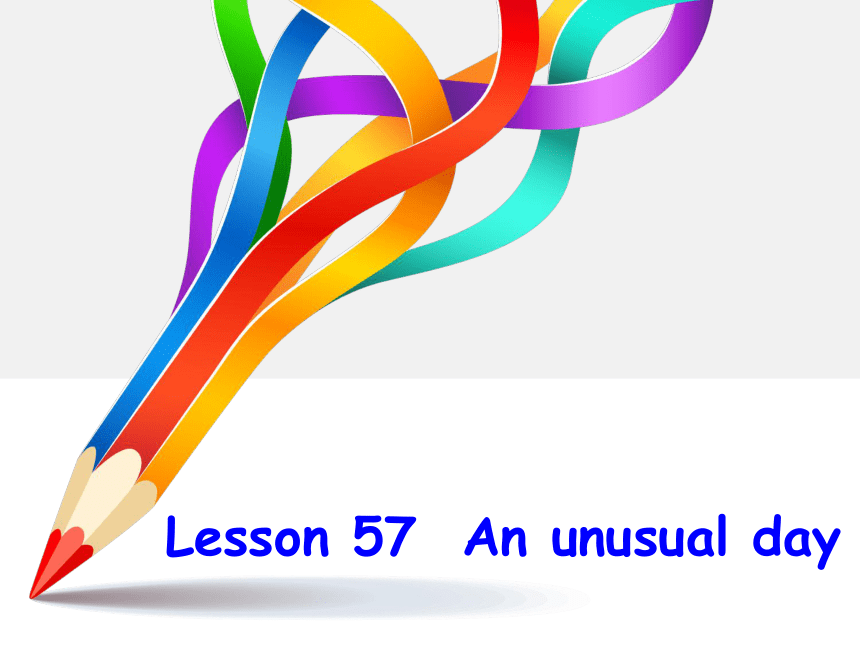 | |
| 格式 | ppt | ||
| 文件大小 | 882.0KB | ||
| 资源类型 | 教案 | ||
| 版本资源 | 新概念英语 | ||
| 科目 | 英语 | ||
| 更新时间 | 2024-01-06 09:04:14 | ||
图片预览

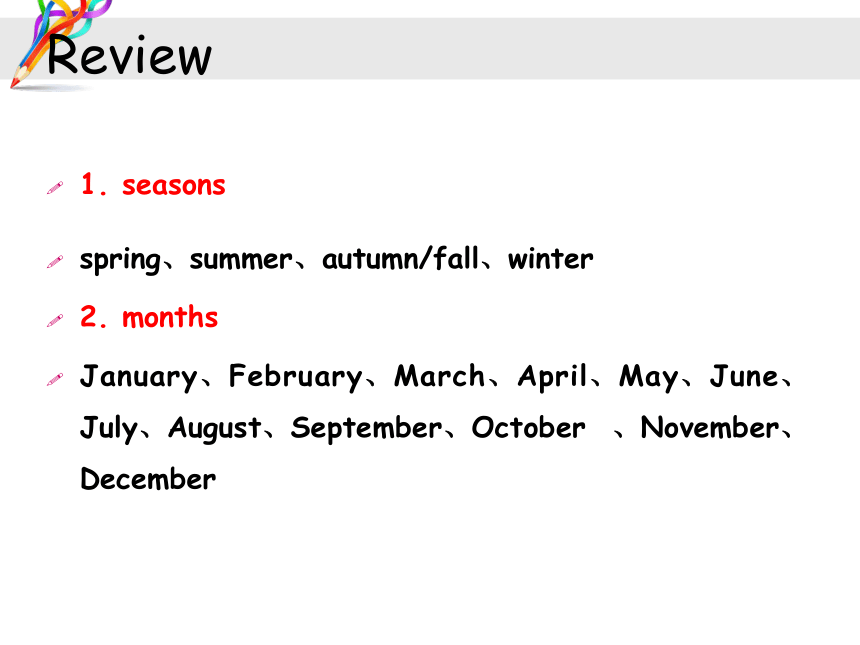
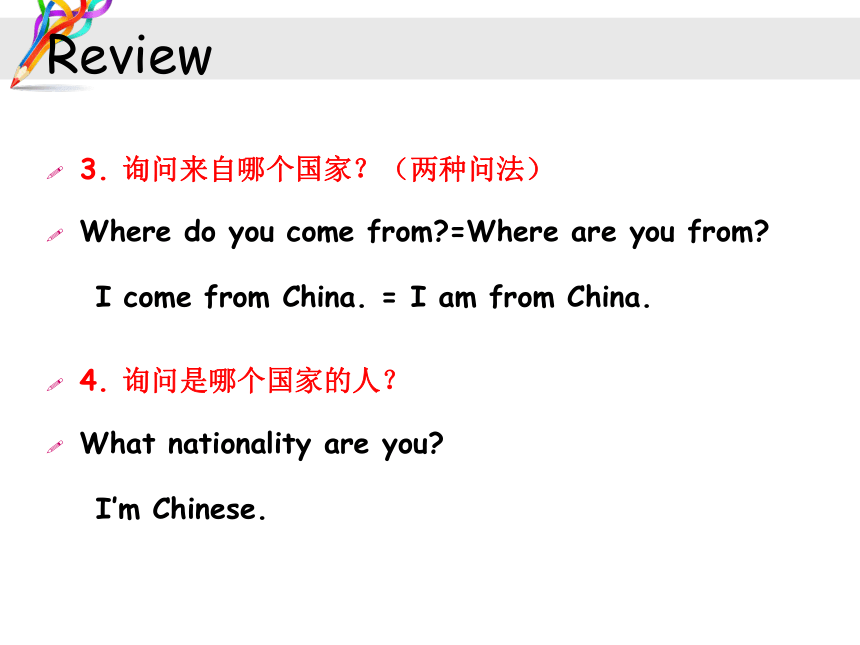
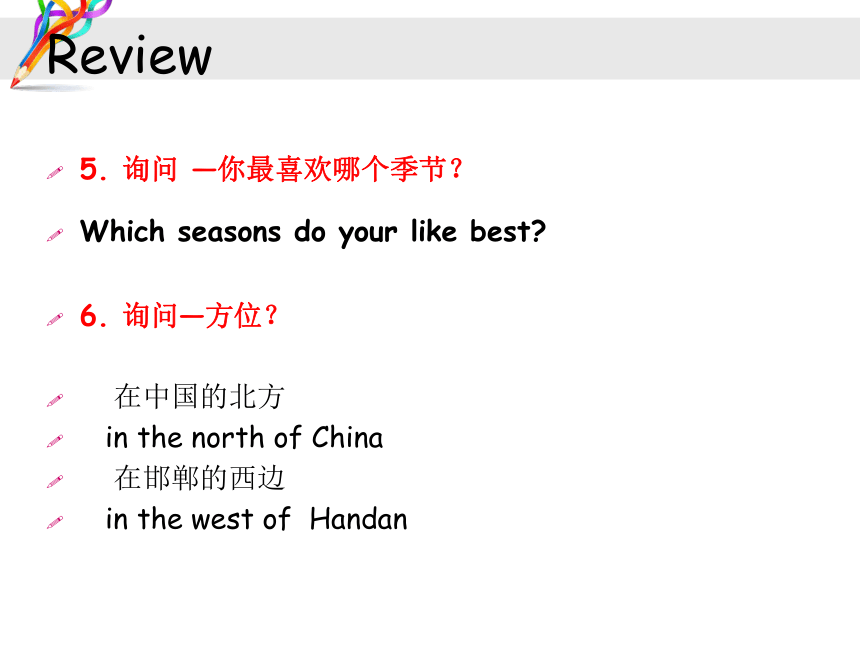
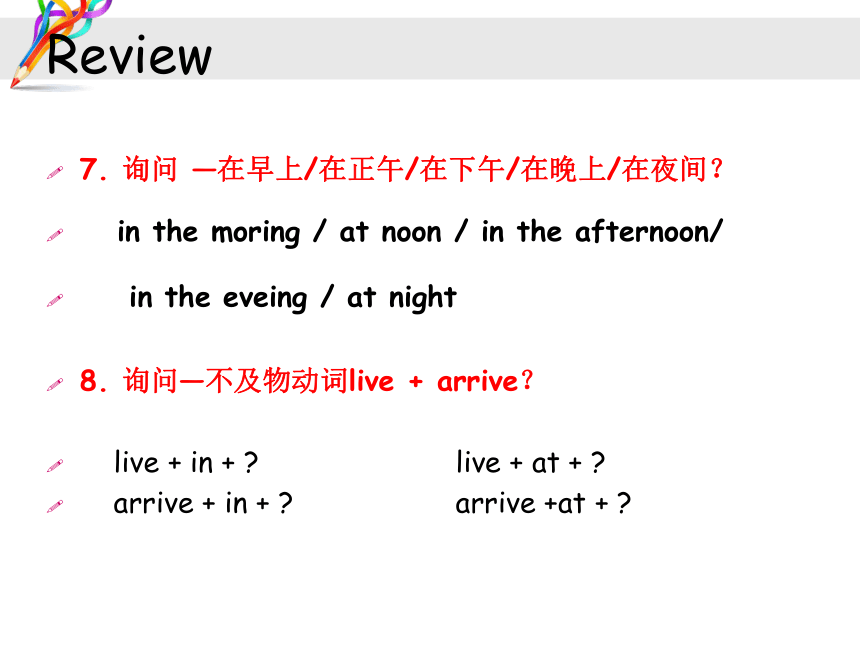
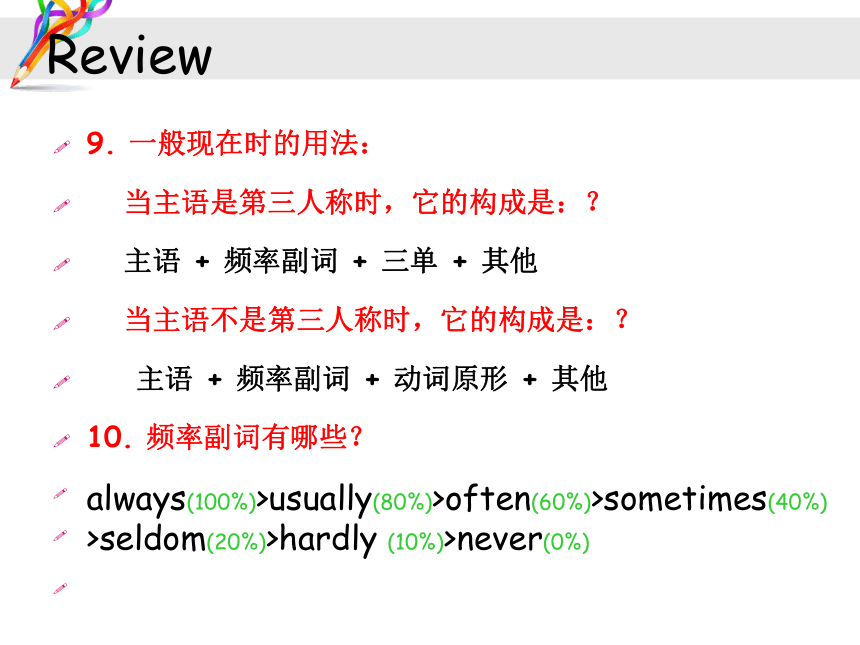

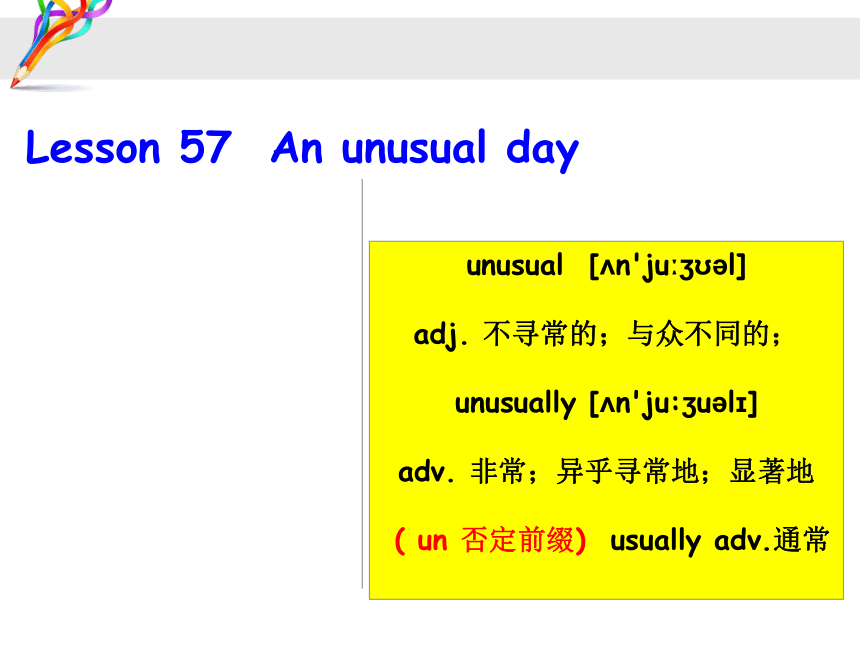
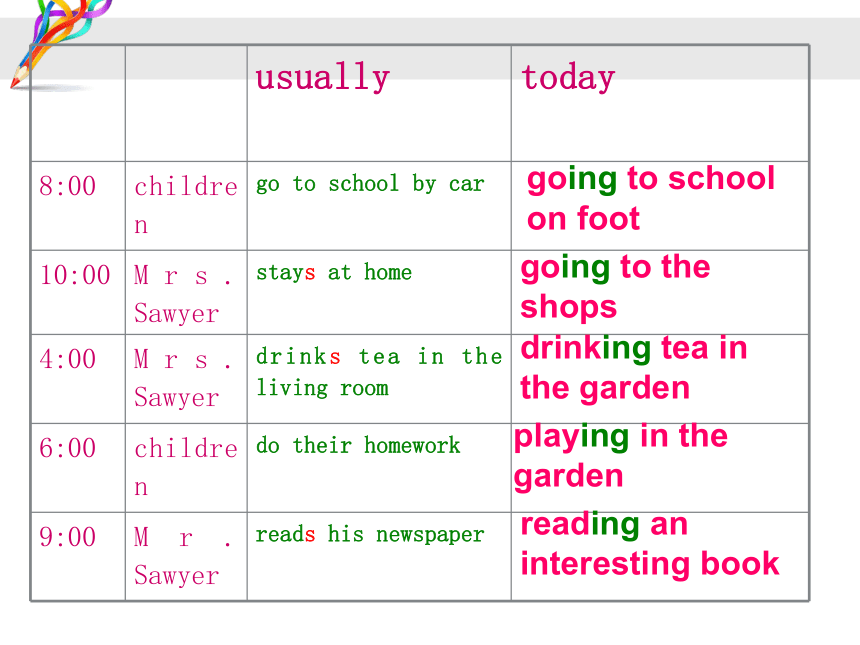
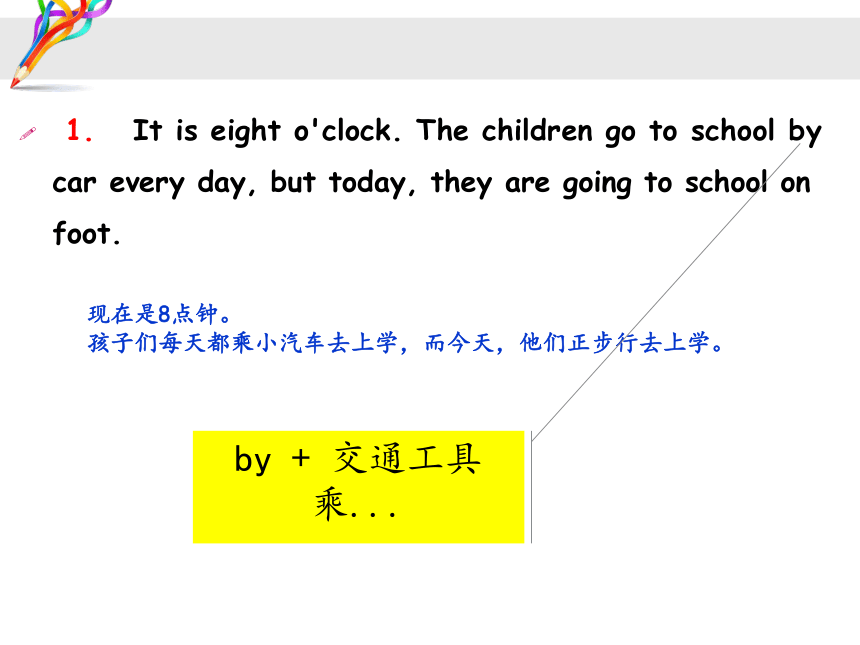
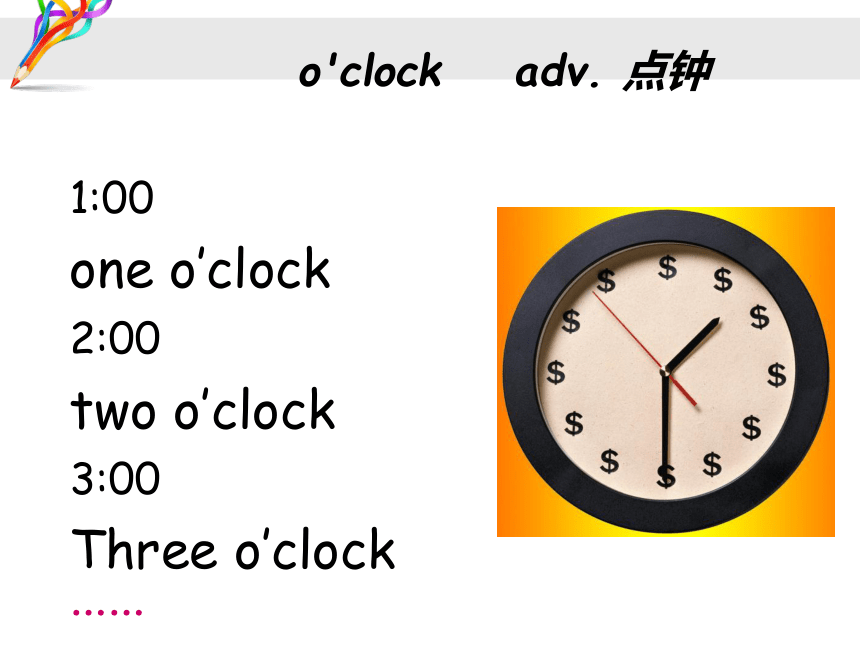
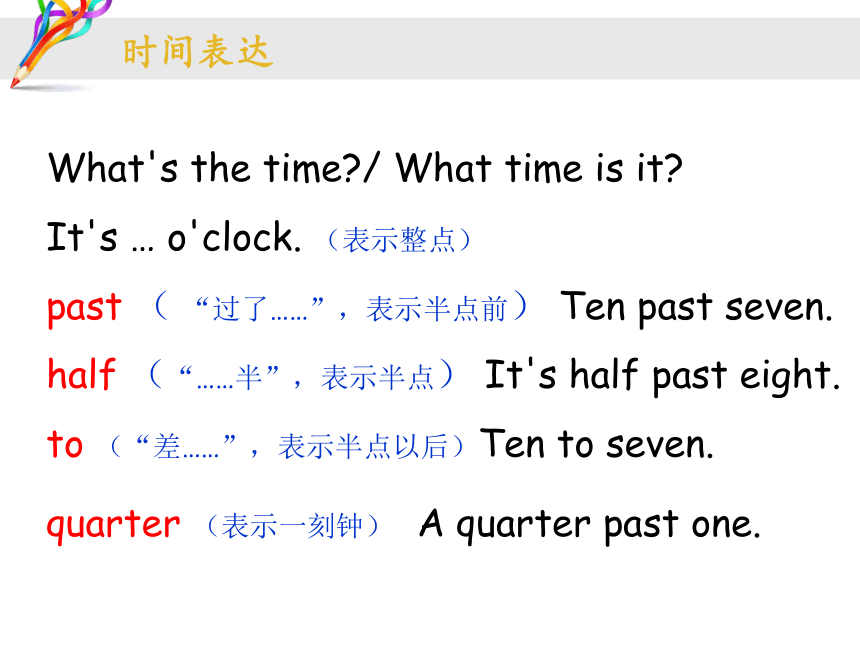
文档简介
(共41张PPT)
Lesson 57 An unusual day
Review
1. seasons
spring、summer、autumn/fall、winter
2. months
January、February、March、April、May、June、July、August、September、October 、November、December
3. 询问来自哪个国家?(两种问法)
Where do you come from =Where are you from
I come from China. = I am from China.
4. 询问是哪个国家的人?
What nationality are you
I’m Chinese.
Review
5. 询问 —你最喜欢哪个季节?
Which seasons do your like best
6. 询问—方位?
在中国的北方
in the north of China
在邯郸的西边
in the west of Handan
Review
7. 询问 —在早上/在正午/在下午/在晚上/在夜间?
in the moring / at noon / in the afternoon/
in the eveing / at night
8. 询问—不及物动词live + arrive?
live + in + live + at +
arrive + in + arrive +at +
Review
9. 一般现在时的用法:
当主语是第三人称时,它的构成是:?
主语 + 频率副词 + 三单 + 其他
当主语不是第三人称时,它的构成是:?
主语 + 频率副词 + 动词原形 + 其他
10. 频率副词有哪些?
Review
always(100%)>usually(80%)>often(60%)>sometimes(40%)>seldom(20%)>hardly (10%)>never(0%)
text
Lesson 57 An unusual day
unusual [ n'ju l]
adj. 不寻常的;与众不同的;
unusually [ n'ju: u l ]
adv. 非常;异乎寻常地;显著地
( un 否定前缀) usually adv.通常
usually
today
8:00 children go to school by car
10:00 Mrs. Sawyer stays at home
4:00 Mrs. Sawyer drinks tea in the living room
6:00 children do their homework
9:00 Mr. Sawyer reads his newspaper
going to school on foot
going to the shops
drinking tea in the garden
playing in the garden
reading an interesting book
1. It is eight o'clock. The children go to school by car every day, but today, they are going to school on foot.
现在是8点钟。
孩子们每天都乘小汽车去上学,而今天,他们正步行去上学。
by + 交通工具
乘...
1:00
one o’clock
2:00
two o’clock
3:00
Three o’clock
……
o'clock adv. 点钟
时间表达
What's the time / What time is it
It's … o'clock. (表示整点)
past ( “过了……”,表示半点前) Ten past seven.
half (“……半”,表示半点) It's half past eight.
to (“差……”,表示半点以后)Ten to seven.
quarter (表示一刻钟)qA quarter past one.
在日常生活中,常用下列简单方法表示时间。
以小时、分钟为单位分别读出数字。
6:31 读作 six thirty-one
10:26读作 ten twenty-six
14:03 读作 fourteen o three
16:15 读作 sixteen fifteen
18:30 读作 eighteen thirty
23:55 读作 twenty-three fifty-five
注:时刻表上的时间大多采用24小时表示法,这样就不需要用a.m.表示上午,p.m.表示下午了。
12
1
2
3
4
5
6
7
8
9
10
11
What's the time / What time is it
2. It is ten o'clock. Mrs. Sawyer usually stays at home in the morning, but this morning, she is going to the shops.
现在是10点整。上午,索耶夫人通常是呆在家里的,但今天上午,他正去商店买东西。
shop[ p] n. 商店
Shopping 购物
Shopping mall 商场
Window shopping
只逛不买
Go shopping 购物,“血拼”
3. It is four o'clock. In the afternoon, Mrs. Sawyer usually drinks tea in the living room. But this afternoon, she is drinking tea in the garden.
现在是4点钟。下午,索耶夫人通常在客厅里喝茶,但今天下午,她正在花园里喝茶。
4. It is six o'clock. In the evening, the children usually do their homework, but this evening, they are not doing their homework. At the moment, they are playing in the garden.
现在是6点钟。晚上,孩子们通常是做作业,而今天晚上,他们没做作业。此刻,他们正在花园里玩。
at the moment 此刻;当时
for a moment 片刻,一会儿;暂时
for the moment 暂时,暂且;目前
at this moment 现在;在这个瞬间
At the last moment the player was able to hit the ball in.
在最后一刻, 那位运动员终于击进了一球。
You should breathe. And enjoy the moment.
你应该深呼吸,享受这一时刻。
Moment ['m um nt] n. 片刻,瞬间
5. It is nine o'clock. Mr. Sawyer usually reads his newspaper at night. But he's not reading his newspaper tonight. At the moment, he's reading an interesting book.
现在是9点钟。索耶先生通常是在晚上看报,但今天晚上他没看报。此刻,他正在看一本有趣的书。
语法知识:
一般现在时
现在进行时
一般现在时
第三人称复数
主语
谓语
The Sawyers live at 87 King Street.
The children go to school.
They often drink tea together.
The children come home from school.
They arrive home early.
The children always do their homework.
They go to bed.
He and his wife watch television.
动词原形:do
一般现在时
第三人称单数
主语
谓语
Mr. Sawyer goes to work.
Their father takes them to school.
Mrs. Sawyer stays at home.
She does the housework.
She always eats her lunch /sees her friends.
Mr. Sawyer usually reads his newspaper.
Mr. Sawyer comes home from work.
He arrives home late.
动词+s/es
一般现在时句式:表经常或习惯性的动作
肯定句: 主语(I/We/You/They)+动词+其他
e.g. I stay at home every day .
主语(He/She/It)+动词加s/es+其他
e.g. He stays at home on Saturdays.
否定句: 主语(I/We/You/They) +do+ not+动词原形+其他
e.g. I don’t stay at home on Saturdays.
主语(He/She/It)+does +not+动词原形+其他
e.g. He doesn’t stay at home on Saturdays.
一般疑问句: Do+主语(I/we/you/they)+动词原形+其他?
e.g. Do you stay at home on Saturdays
Does+主语(he/she/it)+动词原形+其他?
e.g. Does he stay at home on Saturdays
特殊疑问句:疑问词+ do/does+主语+动词原形+其他?
e.g. What do you want
What does she want
What do you do
What does she do
How do you spell it
How does he spell it
时间状语/频度副词: every day/often /always/usually/
every morning/sometimes
例如:
1、我们每天都上学。
2、下课后我们打扫教室。
3、有时我们在操场上踢足球 。
4、我们在学校吃晚饭。
5、他喜欢英语。
6、他是一个学生。
We go to school every day.
We clean the classroom after class.
We sometimes play football on the playground.
We have dinner at school.
He likes English.
He is a student.
Look! They are running .
Listen! Someone is singing in
the next room.
3. The Greens are watching a football
match now.
现在进行时
表示现在、说话瞬间正在进行或发生
的动作。构成:
be动词(am/ is / are) +动词ing形式
标志性词语:
look, listen, now, at present
at the moment
at this moment(在此刻)
现在进行时句式:表示正在进行的动作
肯定句: 主语+be +动词ing+其他
e.g. I am staying at home .
否定句: 主语+be+ not+动词ing+其他
e.g. I am not staying at home.
一般疑问句: Be+主语+动词ing+其他?
e.g. Are you staying at home
特殊疑问句:
疑问词+ be+主语+动词+ing+其他?
e.g. What are you doing?
时间状语: 1.now,at the moment
2. look,listen引出的句子
3. 各种画面、图片以及舞台
展示的动作
eg: What are you doing now (sing)
I’m singing.
1. What are you doing now (read a book)
I’m reading a book.
2. What are Tom and Jack doing now
(ride a bike)
They are riding a bike.
3. What’s your mother doing now
(look at some pictures)
She is looking at some pictures.
改变句型(一般现在时与现在进行时互换):
1.He is swimming.(everyday)
He swims everyday.
2.Lily usually goes shopping with her friends.
Lily is going shopping with her friends.
3.What are you doing now (usually, everyday)
What do you usually do everyday
4.Does he often wash his clothes by himself
Is he washing his clothes by himself
根据英文在钟面上画出时间。
1. half past nine
2. a quarter past seven
3. two to two
4. ten thirty-five
Read and Choose
1.-What’s on the plate - There ______some jam on it.
A. are B. is C. have D. has
2._____sun is shining today.
A.A B. The C./ D. An
3.-Must we hand in the composition now -No. you _______.
mustn't B. needn’t C. may not D. can’t
4.-What’s the date today -________.
Great B. I’m 20 C. Sunday D. The first
5.Hans,with his classmates,_____ basketball every day.
A. Play B. plays D. is playing D. are playing
I usually _______ (go) to school by bus.
She often _______ (watch) TV.
My father _______ (read) magazines at night.
The children _______ (do) homework in the evening.
Dennis sometimes ______ ( arrive) home with her sister.
Let’s correct:
I goes to school at six every day.
He don’t like playing football.
3. They likes playing games.
4. Daming watchs TV in the evening.
5. Does he usually has a party
6. What do they on Sunday
7. Tony goes always to school at eight o’clock.
8. What they eat in the party
9. Lily haves lunch at school.
10. What do his parents usually gives him
go
doesn’t
like
watches
have
do
has
give
do
It is eight o'clock. The children go to school ______ _____ every day, but today, they are going to school __________.
It is ten o'clock. Mrs. Sawyer usually ______ _____ _____ in the morning, but this morning, she is going to the _________.
It is four o'clock. In the afternoon, Mrs. Sawyer usually drinks tea in the ______ ______. But this afternoon, she is drinking tea in the __________.
by car
on foot
stays
at home
shops
living room
garden
It is six o'clock. In the evening, the children usually ____ _____ __________, but this evening, they are not doing their homework. At the moment, they ______ _______ in the garden.
It is nine o'clock. Mr. Sawyer usually ______ ______ _________ at night. But he's not reading his newspaper tonight. At the moment, he _____ __________ an interesting _______.
do their homework
are playing
reads
his newspaper
reading
is
book
看小说
听音乐
看电影
去音乐会
去看足球赛
玩游戏
弹钢琴
上网
说英语
去公园
read novels
listen to the music
go to the cinema
go to the concert
go to watch the football match
play games
play the piano
go online
speak English
go to the park
起床
吃早饭
上课
吃午饭
休息
做运动
吃晚餐
做家庭作业
看电视
上床睡觉
get up
have breakfast
start lesson
have lunch
have a break
do sports
have dinner
do homework
watch TV
go to bed
时刻表示:
1. 表示几点钟用基数词加o’clock
5:00 读作 five o’clock 或 five
2. 表示几点过几分,可以直接读,也可以在分钟后加past,再加小时。但分钟数必须在半小时以内(含半小时)。
five past seven 七点过五分
half past six 六点半
a quarter past eight 八点过一刻
seven past eight 八点过七分
3. 表示几点差几分,在分钟后面加to,再加小时。但分钟必须在半小时以上(不含半小时)。
ten to eight 差十分八点(七点五十分)
a quarter to twelve 差一刻十二点(十一点四十五分)
twenty to six 差二十分六点(五点四十分)
4、时刻前通常加at。如:at seven, at ten twenty
Lesson 57 An unusual day
Review
1. seasons
spring、summer、autumn/fall、winter
2. months
January、February、March、April、May、June、July、August、September、October 、November、December
3. 询问来自哪个国家?(两种问法)
Where do you come from =Where are you from
I come from China. = I am from China.
4. 询问是哪个国家的人?
What nationality are you
I’m Chinese.
Review
5. 询问 —你最喜欢哪个季节?
Which seasons do your like best
6. 询问—方位?
在中国的北方
in the north of China
在邯郸的西边
in the west of Handan
Review
7. 询问 —在早上/在正午/在下午/在晚上/在夜间?
in the moring / at noon / in the afternoon/
in the eveing / at night
8. 询问—不及物动词live + arrive?
live + in + live + at +
arrive + in + arrive +at +
Review
9. 一般现在时的用法:
当主语是第三人称时,它的构成是:?
主语 + 频率副词 + 三单 + 其他
当主语不是第三人称时,它的构成是:?
主语 + 频率副词 + 动词原形 + 其他
10. 频率副词有哪些?
Review
always(100%)>usually(80%)>often(60%)>sometimes(40%)>seldom(20%)>hardly (10%)>never(0%)
text
Lesson 57 An unusual day
unusual [ n'ju l]
adj. 不寻常的;与众不同的;
unusually [ n'ju: u l ]
adv. 非常;异乎寻常地;显著地
( un 否定前缀) usually adv.通常
usually
today
8:00 children go to school by car
10:00 Mrs. Sawyer stays at home
4:00 Mrs. Sawyer drinks tea in the living room
6:00 children do their homework
9:00 Mr. Sawyer reads his newspaper
going to school on foot
going to the shops
drinking tea in the garden
playing in the garden
reading an interesting book
1. It is eight o'clock. The children go to school by car every day, but today, they are going to school on foot.
现在是8点钟。
孩子们每天都乘小汽车去上学,而今天,他们正步行去上学。
by + 交通工具
乘...
1:00
one o’clock
2:00
two o’clock
3:00
Three o’clock
……
o'clock adv. 点钟
时间表达
What's the time / What time is it
It's … o'clock. (表示整点)
past ( “过了……”,表示半点前) Ten past seven.
half (“……半”,表示半点) It's half past eight.
to (“差……”,表示半点以后)Ten to seven.
quarter (表示一刻钟)qA quarter past one.
在日常生活中,常用下列简单方法表示时间。
以小时、分钟为单位分别读出数字。
6:31 读作 six thirty-one
10:26读作 ten twenty-six
14:03 读作 fourteen o three
16:15 读作 sixteen fifteen
18:30 读作 eighteen thirty
23:55 读作 twenty-three fifty-five
注:时刻表上的时间大多采用24小时表示法,这样就不需要用a.m.表示上午,p.m.表示下午了。
12
1
2
3
4
5
6
7
8
9
10
11
What's the time / What time is it
2. It is ten o'clock. Mrs. Sawyer usually stays at home in the morning, but this morning, she is going to the shops.
现在是10点整。上午,索耶夫人通常是呆在家里的,但今天上午,他正去商店买东西。
shop[ p] n. 商店
Shopping 购物
Shopping mall 商场
Window shopping
只逛不买
Go shopping 购物,“血拼”
3. It is four o'clock. In the afternoon, Mrs. Sawyer usually drinks tea in the living room. But this afternoon, she is drinking tea in the garden.
现在是4点钟。下午,索耶夫人通常在客厅里喝茶,但今天下午,她正在花园里喝茶。
4. It is six o'clock. In the evening, the children usually do their homework, but this evening, they are not doing their homework. At the moment, they are playing in the garden.
现在是6点钟。晚上,孩子们通常是做作业,而今天晚上,他们没做作业。此刻,他们正在花园里玩。
at the moment 此刻;当时
for a moment 片刻,一会儿;暂时
for the moment 暂时,暂且;目前
at this moment 现在;在这个瞬间
At the last moment the player was able to hit the ball in.
在最后一刻, 那位运动员终于击进了一球。
You should breathe. And enjoy the moment.
你应该深呼吸,享受这一时刻。
Moment ['m um nt] n. 片刻,瞬间
5. It is nine o'clock. Mr. Sawyer usually reads his newspaper at night. But he's not reading his newspaper tonight. At the moment, he's reading an interesting book.
现在是9点钟。索耶先生通常是在晚上看报,但今天晚上他没看报。此刻,他正在看一本有趣的书。
语法知识:
一般现在时
现在进行时
一般现在时
第三人称复数
主语
谓语
The Sawyers live at 87 King Street.
The children go to school.
They often drink tea together.
The children come home from school.
They arrive home early.
The children always do their homework.
They go to bed.
He and his wife watch television.
动词原形:do
一般现在时
第三人称单数
主语
谓语
Mr. Sawyer goes to work.
Their father takes them to school.
Mrs. Sawyer stays at home.
She does the housework.
She always eats her lunch /sees her friends.
Mr. Sawyer usually reads his newspaper.
Mr. Sawyer comes home from work.
He arrives home late.
动词+s/es
一般现在时句式:表经常或习惯性的动作
肯定句: 主语(I/We/You/They)+动词+其他
e.g. I stay at home every day .
主语(He/She/It)+动词加s/es+其他
e.g. He stays at home on Saturdays.
否定句: 主语(I/We/You/They) +do+ not+动词原形+其他
e.g. I don’t stay at home on Saturdays.
主语(He/She/It)+does +not+动词原形+其他
e.g. He doesn’t stay at home on Saturdays.
一般疑问句: Do+主语(I/we/you/they)+动词原形+其他?
e.g. Do you stay at home on Saturdays
Does+主语(he/she/it)+动词原形+其他?
e.g. Does he stay at home on Saturdays
特殊疑问句:疑问词+ do/does+主语+动词原形+其他?
e.g. What do you want
What does she want
What do you do
What does she do
How do you spell it
How does he spell it
时间状语/频度副词: every day/often /always/usually/
every morning/sometimes
例如:
1、我们每天都上学。
2、下课后我们打扫教室。
3、有时我们在操场上踢足球 。
4、我们在学校吃晚饭。
5、他喜欢英语。
6、他是一个学生。
We go to school every day.
We clean the classroom after class.
We sometimes play football on the playground.
We have dinner at school.
He likes English.
He is a student.
Look! They are running .
Listen! Someone is singing in
the next room.
3. The Greens are watching a football
match now.
现在进行时
表示现在、说话瞬间正在进行或发生
的动作。构成:
be动词(am/ is / are) +动词ing形式
标志性词语:
look, listen, now, at present
at the moment
at this moment(在此刻)
现在进行时句式:表示正在进行的动作
肯定句: 主语+be +动词ing+其他
e.g. I am staying at home .
否定句: 主语+be+ not+动词ing+其他
e.g. I am not staying at home.
一般疑问句: Be+主语+动词ing+其他?
e.g. Are you staying at home
特殊疑问句:
疑问词+ be+主语+动词+ing+其他?
e.g. What are you doing?
时间状语: 1.now,at the moment
2. look,listen引出的句子
3. 各种画面、图片以及舞台
展示的动作
eg: What are you doing now (sing)
I’m singing.
1. What are you doing now (read a book)
I’m reading a book.
2. What are Tom and Jack doing now
(ride a bike)
They are riding a bike.
3. What’s your mother doing now
(look at some pictures)
She is looking at some pictures.
改变句型(一般现在时与现在进行时互换):
1.He is swimming.(everyday)
He swims everyday.
2.Lily usually goes shopping with her friends.
Lily is going shopping with her friends.
3.What are you doing now (usually, everyday)
What do you usually do everyday
4.Does he often wash his clothes by himself
Is he washing his clothes by himself
根据英文在钟面上画出时间。
1. half past nine
2. a quarter past seven
3. two to two
4. ten thirty-five
Read and Choose
1.-What’s on the plate - There ______some jam on it.
A. are B. is C. have D. has
2._____sun is shining today.
A.A B. The C./ D. An
3.-Must we hand in the composition now -No. you _______.
mustn't B. needn’t C. may not D. can’t
4.-What’s the date today -________.
Great B. I’m 20 C. Sunday D. The first
5.Hans,with his classmates,_____ basketball every day.
A. Play B. plays D. is playing D. are playing
I usually _______ (go) to school by bus.
She often _______ (watch) TV.
My father _______ (read) magazines at night.
The children _______ (do) homework in the evening.
Dennis sometimes ______ ( arrive) home with her sister.
Let’s correct:
I goes to school at six every day.
He don’t like playing football.
3. They likes playing games.
4. Daming watchs TV in the evening.
5. Does he usually has a party
6. What do they on Sunday
7. Tony goes always to school at eight o’clock.
8. What they eat in the party
9. Lily haves lunch at school.
10. What do his parents usually gives him
go
doesn’t
like
watches
have
do
has
give
do
It is eight o'clock. The children go to school ______ _____ every day, but today, they are going to school __________.
It is ten o'clock. Mrs. Sawyer usually ______ _____ _____ in the morning, but this morning, she is going to the _________.
It is four o'clock. In the afternoon, Mrs. Sawyer usually drinks tea in the ______ ______. But this afternoon, she is drinking tea in the __________.
by car
on foot
stays
at home
shops
living room
garden
It is six o'clock. In the evening, the children usually ____ _____ __________, but this evening, they are not doing their homework. At the moment, they ______ _______ in the garden.
It is nine o'clock. Mr. Sawyer usually ______ ______ _________ at night. But he's not reading his newspaper tonight. At the moment, he _____ __________ an interesting _______.
do their homework
are playing
reads
his newspaper
reading
is
book
看小说
听音乐
看电影
去音乐会
去看足球赛
玩游戏
弹钢琴
上网
说英语
去公园
read novels
listen to the music
go to the cinema
go to the concert
go to watch the football match
play games
play the piano
go online
speak English
go to the park
起床
吃早饭
上课
吃午饭
休息
做运动
吃晚餐
做家庭作业
看电视
上床睡觉
get up
have breakfast
start lesson
have lunch
have a break
do sports
have dinner
do homework
watch TV
go to bed
时刻表示:
1. 表示几点钟用基数词加o’clock
5:00 读作 five o’clock 或 five
2. 表示几点过几分,可以直接读,也可以在分钟后加past,再加小时。但分钟数必须在半小时以内(含半小时)。
five past seven 七点过五分
half past six 六点半
a quarter past eight 八点过一刻
seven past eight 八点过七分
3. 表示几点差几分,在分钟后面加to,再加小时。但分钟必须在半小时以上(不含半小时)。
ten to eight 差十分八点(七点五十分)
a quarter to twelve 差一刻十二点(十一点四十五分)
twenty to six 差二十分六点(五点四十分)
4、时刻前通常加at。如:at seven, at ten twenty
同课章节目录
